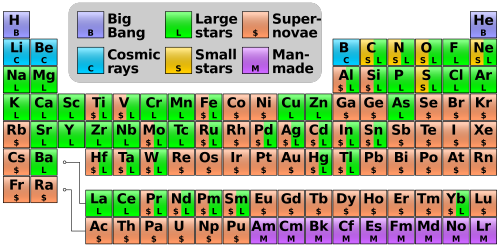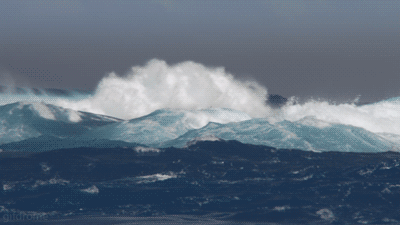Latest Posts by hannahhaifisch - Page 3

Why Some Images Trigger Seizures
The key, they propose, is a particular repetitive pattern of neural activity in the brain known as gamma oscillations that occurs when people view certain images, such as black and white bar patterns, and not others. In fact, the researchers say, it’s possible that those kinds of images are responsible for other problems, such as migraine headaches, particularly in people who are generally sensitive to light.
The research is in Current Biology. (full open access)

Where Your Elements Came From
The hydrogen in your body, present in every molecule of water, came from the Big Bang. There are no other appreciable sources of hydrogen in the universe. The carbon in your body was made by nuclear fusion in the interior of stars, as was the oxygen. Much of the iron in your body was made during supernovas of stars that occurred long ago and far away. The gold in your jewelry was likely made from neutron stars during collisions that may have been visible as short-duration gamma-ray bursts. Elements like phosphorus and copper are present in our bodies in only small amounts but are essential to the functioning of all known life. The featured periodic table is color coded to indicate humanity’s best guess as to the nuclear origin of all known elements. The sites of nuclear creation of some elements, such as copper, are not really well known and are continuing topics of observational and computational research.
Image Credit: Cmglee (Own work) CC BY-SA 3.0 or GFDL, via Wikimedia Commons



Many solids can dissolve in liquids like water, and while this is often treated as a matter of chemistry, fluid dynamics can play a role as well. As seen in this video by Beauty of Science, the dissolving candy coating of an M&M spreads outward from the candy. This is likely surface-tension-driven; as the coating dissolves, it changes the surface tension near the candy and flow starts moving away thanks to the Marangoni effect. With multiple candies dissolving near one another, these outward flows interfere and create more complex flow patterns.
These flows directly affect the dissolving process by altering flow near the candy surface, which may increase the rate of dissolution by scouring away loose coating. They can also change the concentration of dissolved coating in different areas, which then feeds back to the flow by changing the surface tension gradient. (Video and image credit: Beauty of Science)

0063
The full rotation of the Moon as seen by NASA’s Lunar Reconnaissance Orbiter.


Physicists discover hidden aspects of electrodynamics
Radio waves, microwaves and even light itself are all made of electric and magnetic fields. The classical theory of electromagnetism was completed in the 1860s by James Clerk Maxwell. At the time, Maxwell’s theory was revolutionary, and provided a unified framework to understand electricity, magnetism and optics.
Now, new research led by LSU Department of Physics and Astronomy Assistant Professor Ivan Agullo, with colleagues from the Universidad de Valencia, Spain, advances knowledge of this theory. Their recent discoveries have been published in Physical Review Letters.
Maxwell’s theory displays a remarkable feature: it remains unaltered under the interchange of the electric and magnetic fields, when charges and currents are not present. This symmetry is called the electric-magnetic duality.
However, while electric charges exist, magnetic charges have never been observed in nature. If magnetic charges do not exist, the symmetry also cannot exist. This mystery has motivated physicists to search for magnetic charges, or magnetic monopoles. However, no one has been successful. Agullo and his colleagues may have discovered why.
Read more ~ SpaceDaily

Latest SDO PFSS image for: AIA 0171

Modular Origami Star by Maria Sinayskaya http://flic.kr/p/dJtry6

Atpvts


Where you will find me today { @ NASA } contemplating formations like ‘cloud streets’ like this activity over the Bering Sea | 📷via @explorenasa + NASA/Goddard | research for #spacelandings2017 #atmosphericresearch #newterrain #environment #sciencematters { cylinders of #spinning #air }





Four Planet System in Orbit, Directly Imaged | Planetary Landscapes Credit: Many Worlds
This evocative movie of four planets more massive than Jupiter orbiting the young star HR 8799 is a composite of sorts, including images taken over seven years at the W.M. Keck observatory in Hawaii.
Read more here.

0048




“X-rays reveal the inner beauty of shells.” National Geographic. March 1955.

325 Triangles








Images of Jupiter taken by the Juno spacecraft during perijove 5 (March 27th 2017) and processed by the public.
Credits; 1: J.P. Hersey 2: Phablo Araujo 3: James Tyrwhitt-Drake 4: Björn Jónsson 5 & 6: Jason Major 7: Uriel 8: Melissa Egan

#45
Title: Grey squares rotating
Technique: Drawing with Stabilo markers on printed Blender animation (16 Frames)
Is dark energy an illusion?
Variations in universe’s density can explain away dark energy, theorists claim from Latest News from Science Magazine http://ift.tt/2nx2XYs via IFTTT




Water is one of those strange materials that expands when it freezes, which raises an interesting question: what happens to a water drop that freezes from the inside out? A freezing water droplet quickly forms an ice shell (top image) that expands inward, squeezing the water inside. As the pressure rises, the droplet develops a spicule – a lance-like projection that helps relieve some of the pressure.
Eventually the spicule stops growing and pressure rises inside the freezing drop. Cracks split the shell, and, as they pull open, the cracks cause a sudden drop in pressure for the water inside (middle image). If the droplet is large enough, the pressure drop is enough for cavitation bubbles to form. You can see them in the middle image just as the cracks appear.
After an extended cycle of cracking and healing, the elastic energy released from a crack can finally overcome surface energy’s ability to hold the drop together and it will explode spectacularly (bottom image). This only happens for drops larger than a millimeter, though. Smaller drops – like those found in clouds – won’t explode thanks to the added effects of surface tension. (Image credit: S. Wildeman et al., source)


A photo of Saturn. Took by Hubble with HSTWFPC2 on December 09, 2002 at 10:36:16. Detail page on OPUS database.

Geometric Animations / 170402

0029